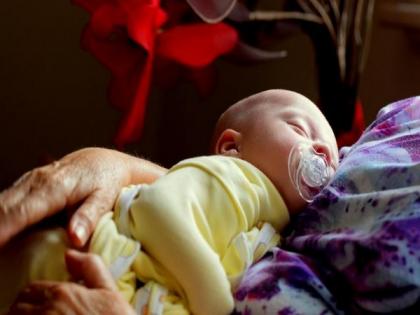Study hints long term impacts of higher red blood cell transfusions among premature babies
By ANI | Updated: January 3, 2021 09:05 IST2021-01-03T08:55:35+5:302021-01-03T09:05:02+5:30
A study published in 'The New England Journal of Medicine' compared thresholds for blood transfusions in premature babies to examine their severe and long-term impacts.

Study hints long term impacts of higher red blood cell transfusions among premature babies
A study published in 'The New England Journal of Medicine' compared thresholds for blood transfusions in premature babies to examine their severe and long-term impacts.
A team lead by researchers of George Mason University claimed that very low birth weight infants are at high risk for anaemia and often need blood transfusions to survive.
Some doctors use a higher level and some use a lower level of red blood cells to order a transfusion. A National Institutes of Health-funded study suggests that providing a higher threshold of red cells within clinically accepted limits (i.e., using a higher level of red blood cells when ordering a transfusion) offers no advantage in survival or reduction in neurological impairment over a lower threshold.
Very preterm infants (born before 29 weeks of pregnancy) and those weighing less than 1,000 grams (slightly more than 2 pounds) are at high risk for anaemia because of their early stage of development, reduced ability to produce red blood cells, and need for blood sampling as part of their intensive medical care.
Previous studies suggest that anaemic infants who received transfusions at a higher haemoglobin threshold within the currently accepted range would have a lower risk of death or developmental problems. Measuring haemoglobin, a protein produced in red blood cells, indicates the proportion of red blood cells. Haemoglobin transfusion thresholds for preterm infants vary according to weight, stage of maturity and other factors.
Of 845 infants assigned to a higher haemoglobin threshold, 50.1% died or survived with neurodevelopmental impairment, compared to 49.8% of 847 infants assigned to a lower threshold. When the two-component outcomes were evaluated separately, the two groups also had similar rates of death (16.2% vs. 15%) and of neurodevelopmental impairment (39.6% vs 40.3%).
The authors evaluated the babies at two years of age and conclude that a higher haemoglobin threshold increased the number of transfusions, but did not improve the chance of survival without neurodevelopmental impairment.
"The findings are likely to be used to guide transfusion practice in the future for these infants; studies in premature infants are needed to guide care for these small and vulnerable infants; studies funded by NIH in multi-site networks are vitally important to the health of these fragile babies," explains Higgins.
( With inputs from ANI )
Disclaimer: This post has been auto-published from an agency feed without any modifications to the text and has not been reviewed by an editor
Open in app